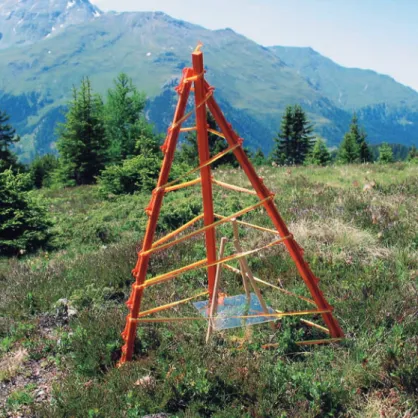79 Jber. Natf. Ges. Graubünden 114 (2007), Seiten 79 – 80
Ground-dwelling spiders (Arachnida:
Araneae) from the dwarf-shrub heath to subalpine coniferous forest: diversity, distribution and its predictors
von Patrick Muff
1, 2, Christian Kropf
2, Holger Frick
1, 2, Wolfgang Nentwig
1und Martin H. Schmidt
1Adresse:
1 Universität Bern Zoologisches Institut Baltzerstrasse 6 CH-3012 Bern
patrick.muff@gmail.com
Bodenbewohnende Spinnen von der Zwerg- strauchheide bis zum subalpinen Nadelwald:
Vielfalt, Verteilung und ihre Vorhersagbarkeit
Zusammenfassung
Habitatübergänge wie das Waldgrenzenökoton im alpinen Raum sind wichtige ökologische Elemente in der Landschaft und weisen oft eine hohe Arten- zahl auf.
In dieser Arbeit wurde die Verteilung von boden- bewohnenden Spinnen von der Zwergstrauchheide über einzeln stehende Fichten bis zum subalpinen Nadelwald untersucht. Es stellte sich heraus, dass die Artenzahl vom Offenland zum Wald hin tendenziell abnimmt. Im Wald sind vermehrt Habitatspezialisten anzutreffen. Es wurden jedoch kaum Arten gefunden, welche ausschliesslich in einem Habitat vorkamen.
Die insgesamt 6251 untersuchten Spinnen konn- ten 102 Arten zugeteilt werden. Dabei wurde auch
eine für die Wissenschaft bisher unbekannte Art (Ca- racladus sp.) entdeckt. Fünf der Arten sind Neufunde für Graubünden, zwei Arten sind Alpenendemiten.
Schlagworte:
Spinnen, Habitat, Waldgrenze, Über- gang, Alp Flix, Graubünden
Habitat edges are major elements in landscapes.
As they combine characteristics of both adjoining habitat types, boundaries potentially contain a high biodiversity. However, knowledge about their habi- tat quality and their influence on the distribution of organisms are still limited. In this study, we aimed to assess the value of such a boundary (i.e. the alpine timberline) while analysing the degree to which the community change at a habitat edge is determined by the broad-scale spatial transition from one habi- tat to the other, or by fine-scale environmental in- fluences. We compared the distribution of epigeic spider species from the dwarf-shrub heath to sub-
2 Naturhistorisches Museum Bern Abteilung Wirbellose
Bernastrasse 15 CH-3005 Bern
80
Jber. Natf. Ges. Graubünden 114 (2007)
alpine coniferous forest with the distribution around stand-alone trees at the alpine timberline on the Alp Flix (CH, Canton Grisons, 1950 m). 17 environmen- tal variables and two spatial parameters were used to characterise five structural different habitat zones:
the open land and forest, representing two macro- habitats, and three microhabitats linked and defined by their location relative to a single spruce tree at the timberline: next to the trunk, at the end of branch cover and in the adjoining open area outside of branch cover. These five zones represented the whole gradient of habitat structures from forest to open land and thus allowed us to compare the mac- rospatial gradient across these two habitats with the microspatial gradient across the three areas around a tree. In each of the five different habitat zones we placed 15 pitfall traps (Fig. 1) which were operated from Mai 2005 to Mai 2006.
Our analyses of the 6251 adult specimens collect- ed (102 species, 14 families) showed that total spe- cies richness and activity density of all species de- creased from the open land to forest, although this pattern varied according to family. It is notable that all five habitat zones were dominated by certain spe- cies, but no species was found exclusively in only one habitat. While most species preferred the open
land, the forest was inhabited by a higher proportion of specialists. Regarding the timberline, the zone in the adjoining open area outside of branch cover may have been most attractive followed by the zone next to the trunk. In contrast, few if any species seemed to prefer the zone at the end of branch cover. When linking this variation in the species distribution to the environmental and spatial variables recorded we found a superior influence of the environment (24%
of the explained variation) compared to space (8%), in addition to a strong overlap between these two factors (16%). We could show that the spider com- munities found across the alpine timberline can be differentiated according to light preferences of single species, whereas vegetation cover did not have any large effects. These preferences appeared to be fairly constant within families and agreed well with the requirements of families found in lowland habitats across Central Europe. Since the small area around a single tree at the timberline offered a similar broad spectrum of environmental conditions as the open land and forest together, it provided habitats for both open land and forest spider species as well as some possible timberline specialists. Our findings indicate that heterogeneous microspatial structures and hab- itat edges in particular may be sufficient to maintain very contrasting communities and thus contribute to invertebrate conservation.
The study recorded one species new to science (Caracladus sp.) and five species new to the Canton Grisons (Centromerita bicolor, Centromerita concinna, Hilaira excisa, Meioneta alpica and Tallusia experta).
Other remarkable species included Meioneta orites and Panamomops palmgreni, both endemic to the Alps.
Three species showed remarkable morphological characteristics and were analysed in more detail. We found males of Pelecopsis radicicola without the char- acteristic longitudinal depression on the raised cara- pace. We could show that the males of Meioneta alpica have a considerably variable lamella charac- teristica, which is nevertheless distinct from the sister species Meioneta ressli. Our finding of intermediate forms of the head region described for Metopobactrus prominulus and M. schenkeli, respectively, challenges the species status of M. schenkeli. These findings dem- onstrate that the known distribution and taxonomic status of spiders in the Central Alps are still incom- plete and further work on arthropods in remote ar- eas is strongly encouraged.
Fig. 1: Pitfall trap in the open land.
